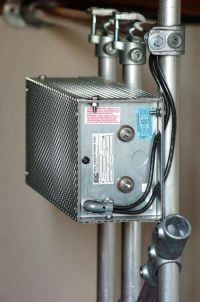wind turbine braking
Overspeed control of a wind turbine is exerted in two main ways: aerodynamic stalling or furling, and mechanical braking. Furling is the preferred method of slowing wind turbines.
 |
| Dynamic braking resistor for a wind turbine manufactured
by IPC resistors
|
Braking of a wind turbine can also be done by dumping energy from the generator into a resistor bank, thereby converting the kinetic energy of the turbine rotation into heat. This method is useful if the connetic load on the generator is suddenly reduced or is too small to keep the turbine speed within its allowed limit. Cyclically braking causes the blades to slow down, which increases the stalling effect, reducing the efficiency of the blades. This way, the turbine's rotation can be kept at a safe speed in faster winds while maintaining (nominal) power output.
A mechanical drum brake or disk brake is used to hold the turbine at rest for maintenance. Such brakes are usually applied only after blade furling and electromagnetic braking have reduced the turbine speed, as the mechanical brakes would wear quickly if used to stop the turbine from full speed.
